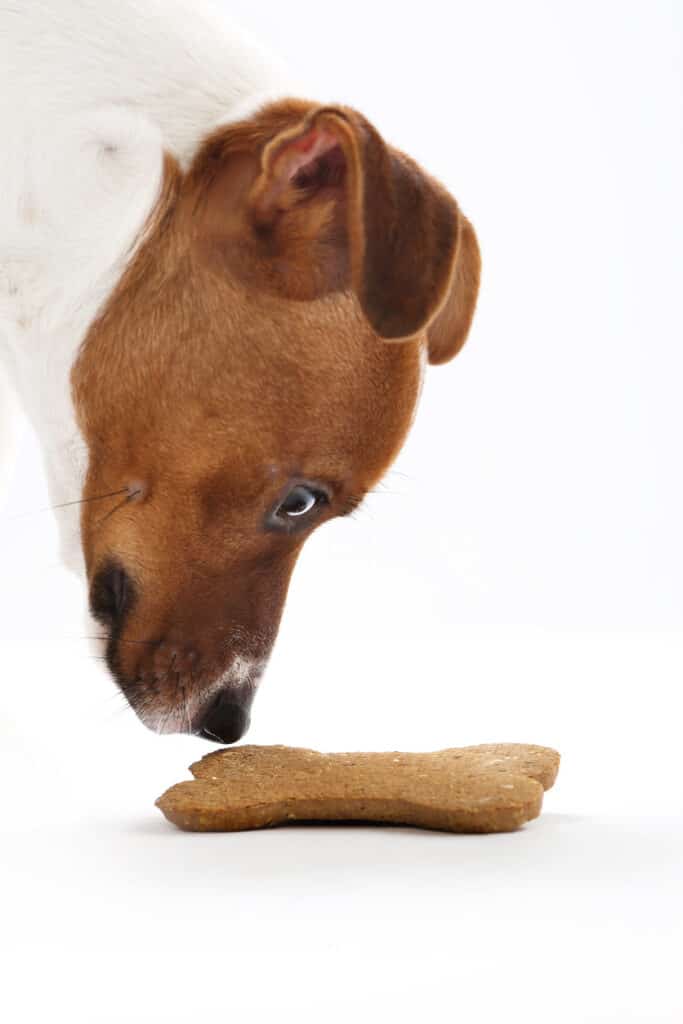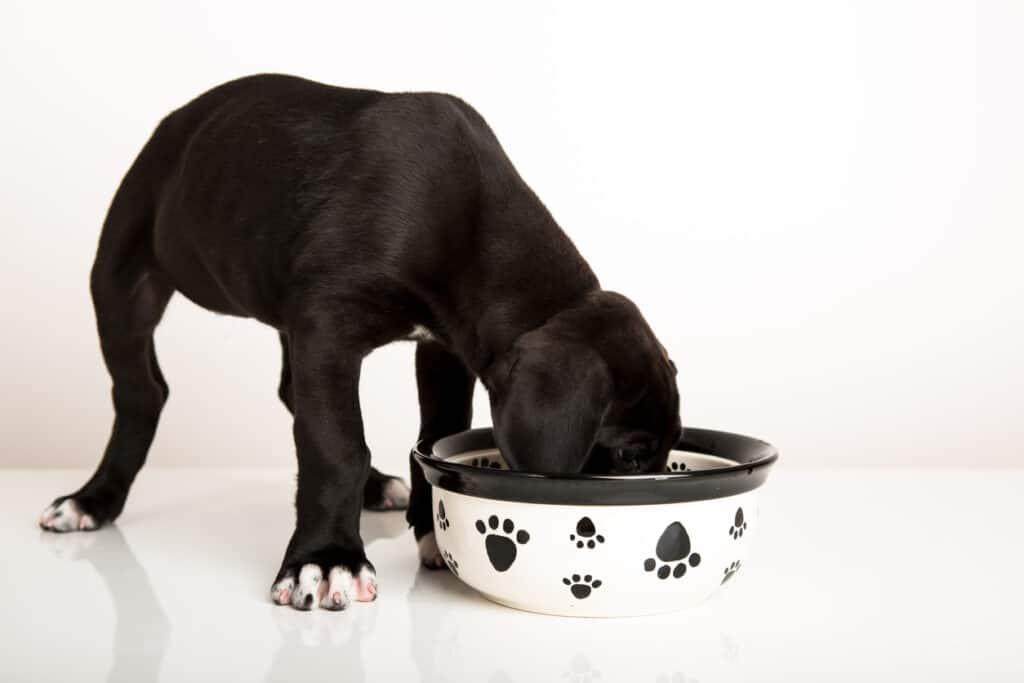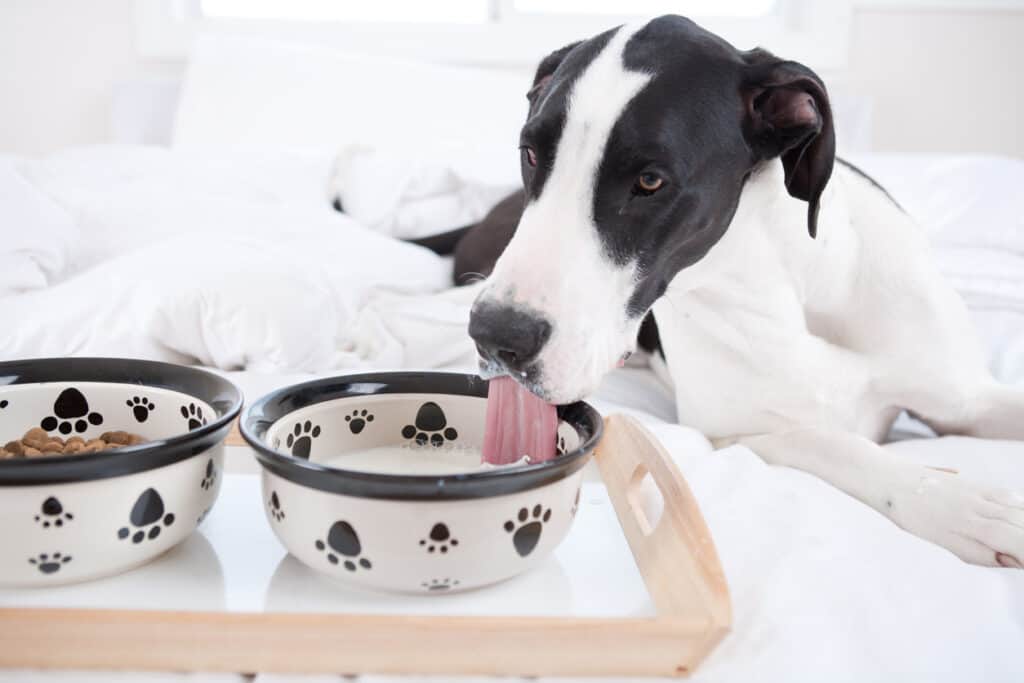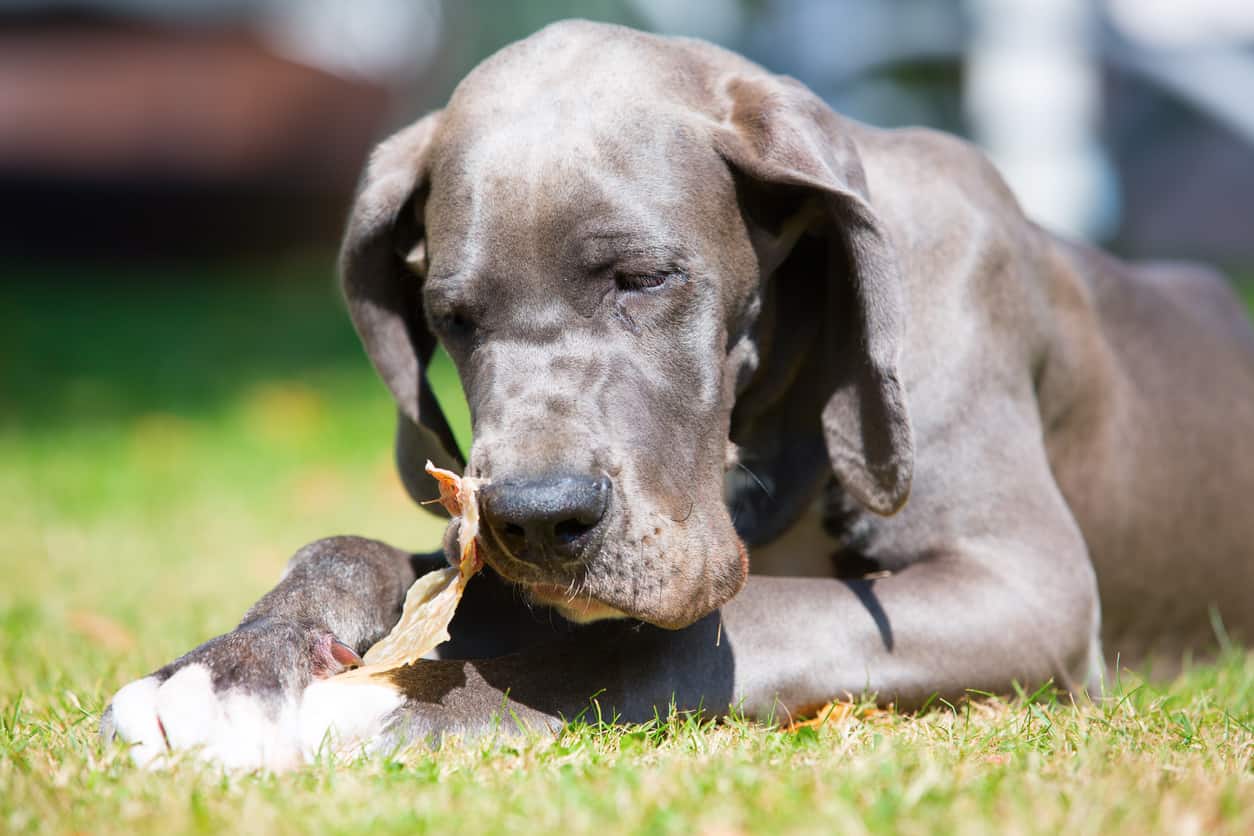Great Danes are one of the largest dogs on earth. While most experts agree that Great Danes as a breed are the product of mixing of Irish Wolfhound and English Mastiff, everyone agrees that they are animals with specific nutrition requirements that anybody interested in owning or adopting should be aware of. Referencing a Great Dane feeding chart—both for your puppy and your adult Dane—is a helpful way to keep your Great Dane’s diet on track.

Great Danes have a much longer puppyhood than most other breeds. The reason for this is that it takes about three years for Great Danes to achieve their full, filled-out adult size, and the first eighteen months of a Great Dane’s life are particularly critical nutritionally speaking due to their need for a diet that supports a slow and steady growth.
Below is a suggested Great Dane feeding chart for a Great Dane puppy. Prospective owners should note that charts are guidelines and that every puppy is different. For example, if you have a very hyper and active Great Dane puppy, it will require slightly more food than a Great Dane puppy that spends the majority of its time snoozing.
Tracking how much your puppy is eating is important so that you and your veterinarian can develop the right feeding plan for your puppy’s specific growth requirements. Consulting with your veterinarian can also help you determine the best type of food for your puppy – wet, dry, or some combination. In all cases, a dog or puppy food made from quality ingredients such as beef or chicken is preferable to one made with meat byproducts.
Great Dane Feeding Chart (Puppy)

| Age [months] | Food [cups] | Meals / day |
| 2 | 2 – 4 | 3 |
| 3 | 3 – 5 | 3 |
| 4 | 4 – 6 | 3 |
| 5 | 5 – 7 | 2 |
| 6 | 6 – 8 | 2 |
| 7 | 6 – 9 | 2 |
| 8 | 6 – 9 | 2 |
| 9 | 7 – 10 | 2 |
| 10 – 12 | 7 – 10 | 2 |
| 12 – 18 (females) | 6 – 9 | 2 |
| 12 – 18 (males) | 7 – 10 | 2 |
Careful readers will note that for the first few months in a new home, a Great Dane puppy will likely require at least three meals a day. Planning a Great Dane puppy’s diet is important to the future health of the puppy. Slow and steady growth is essential to the long-term health of a Great Dane because its skeletal health is largely determined within the first year of its life. If a Great Dane is fed without performing due diligence on the nutritional composition of the food, the odds that it will develop the afflictions to which the breed is already predisposed will increase exponentially. For example, hip and elbow dysplasia plague Great Danes and other large dog breeds, and the deformity can be triggered if a Great Dane grows too quickly for its skeletal structure to sustain.
Great Dane puppies are also at risk of developing a number of growth-related diseases within their first year of life, which is so critical to their skeletal development. One of these diseases is called panosteitis, or “pano” for short. Pano is a painful inflammation of the outer surface of a long bone. The inflammation occurs on the shaft and can occur on one or multiple bones. Pano can cause great discomfort and lameness in puppy’s or dogs because the animals will shift their weight around to try and reduce the pain in the afflicted area.
Another growth disease that Great Danes are susceptible to if not correctly assigned a Great Dane feeding chart is called Metaphyseal Osteopathy. This is a bone disease that typically afflicts Great Danes when they’re very young, such as between three to six months of age. The condition is treatable, but it cannot be cured.
Finally, Great Dane puppies whose nutritional need are not met are especially at risk of developing Wobbler syndrome. Wobbler syndrome is a serious condition affecting the neck vertebrae that causes the Great Dane to develop an odd, poor-quality gait that greatly reduces its quality of life. While a Great Dane or large dog breed can contract Wobbler syndrome at any age, recent research suggests that Great Dane puppies that are not fed in a way that promotes healthy, sustainable growth are at particular risk. Wobbler syndrome can be treated, but it is expensive to do so. Great Danes with Wobbler syndrome may be prescribed medication to reduce the inflammation in the neck, or a veterinarian may recommend surgery to reduce the compression occurring on the spinal cord.
Speaking of expensive, however you go about designing a Great Dane feeding chart, a Great Dane is expensive to feed. An adult Great Dane will cost, at minimum, around $100 to feed. So, it’s important for prospective owners to invest time in learning how to provide sustenance that will translate into strong and healthy Great Danes. Choosing a good breeder or adoption organization will go a long way towards facilitating your knowledge and increasing the likelihood that you’ll be able to raise a healthy Great Dane. These professionals will be able to make specific food recommendations, as well as point you in the direction of a reliable supplier so that you’re able to continue providing the puppy or dog during its transition to living in your home.
Even if you intend on changing the brand of food you provide your Great Dane, it’s helpful to keep the food consistent with that of the animal’s original home when you bring it into yours. Great Danes in particular are well-known to have sensitive stomachs that are easily affected by external factors, such as a change in environment.
One thing to note is that male Great Danes will require more food than females, likely even as puppies. When appraising puppy food for your Great Dane, you’ll want to pay special attention to calcium and phosphorus, as these facilitate bone growth and health, and the protein ratio.
Can Great Danes Eat Puppy Food?

A common question that comes up when discussing a Great Dane feeding chart is whether or not Great Dane puppies can or should eat puppy food, given the amount of calories in standard puppy food. While puppy food does have more calories than dog food, by learning to read the labels, owners can learn to discern between which types of puppy food are suitable for their Great Dane puppy and which are not.
Equally important when considering what to feed your Great Dane puppy is how much to feed your your Great Dane puppy. As previously mentioned, Great Dane puppies can have puppy food, but puppy foods have higher caloric counts in order to spur along the rapid growth that most puppies undergo (and complete) by their first birthday. Because Great Danes grow for so much longer, too much puppy food can actually cause them to develop too quickly, which results in an increased risk of the aforementioned health risks consistent with overfeeding a Great Dane puppy.
The physical transformation that a Great Dane puppy goes through in its first year of life cannot be overstated. Born weighing 1-2 pounds, by the time Great Dane puppies are eight weeks old, they’re already the size of many other full-grown dog breeds. By the time they reach their first birthday, they will weigh around 100 pounds. Supporting the nutrition of a Great Dane puppy will involve examining the micronutrients in their food as well as the overall caloric count, and this can also be done with your veterinarian.
Puppy foods containing 1-1.5% of calcium are great for Great Dane puppies because they need a good promotion of bone health. Bone health will likely be discussed at length with both the breeder or adoption organization and the vet, because the foundation of a Great Dane’s health essentially rests on having a strong skeletal structure. Where bones are concerned, micronutrients are especially important. Within the pre-specified range for calcium, the ideal amount of calcium should fall on the low-to-mid percentage area. Additionally, phosphorous should be present as a ratio to calcium (see below for more information).
Calcium | Phosphorous range |
| 1% | 0.67 % – 1.0% |
| 1.25% | 0.83% – 1.25% |
| 1.5% | 1.0%-1.5% |
Another aspect of Great Dane puppy nutrition is the percentage of protein in the food. Typically, puppy food with 20-26% protein will be appropriate for a Great Dane puppy. The majority of calories in puppy food come from protein and fat, and the ideal range of calories for Great Dane puppies is about 350-400 calories per cup. This amount of food promotes healthy growing, while also satiating the puppy during feedings. Brands that use corn-based fillers or meat byproducts should be avoided, and all-natural ingredients such as “beef” or “chicken” should be the standard for your puppy.
How to tell if your Great Dane is eating enough?
An easy way to get a general sense of if your Great Dane puppy is growing in a healthy way is by appraising its body composition. Because they grow so quickly, Great Dane puppies will likely resemble lanky adolescents for some time, but they should never be skinny or scrawny, and you should never be able to see all of their ribs and hipbones. Instead, a Great Dane puppy should be slim, with perhaps just the last rib at the back of the ribcage slightly visible to the naked eye. If you have doubts about the trajectory of your Great Dane puppy’s growth, a veterinarian can offer a source of both assistance and reassurance.
After you’ve carefully overseen your Great Dane puppy’s growth for the first three years of its life – congratulations! You will likely have a healthy, well-proportioned animal whose body is strong enough to let it live until the later years of its standard lifespan, or perhaps even longer.
Following a Great Dane feeding chart becomes easier when they’re adults, but it should be reiterated that owning a Great Dane is an extremely expensive responsibility. Even small female Great Danes will typically weigh well over 110 pounds and require dozens of cups of food over the course of a single week.
Sample Great Dane Feeding Chart (Adult)
Normal Activity | Higher Activity | |||
| Weight | (g) | Cups | (g) | Cups |
| 110lbs / 50kg | 634g | 7 | 765g | 8+3/8 |
| 121lbs / 55kg | 681g | 7+4/8 | 822g | 9 |
| 132lbs / 60kg | 727g | 8 | 877g | 9+5/8 |
| 143lbs / 65kg | 772g | 8+4/8 | 931g | 10+2/8 |
| 154lbs / 70kg | 816g | 9 | 985g | 10+6/8 |
| 165lbs / 75kg | 859g | 9+3/8 | 1037g | 11+3/8 |
| 176lbs / 80kg | 902 | 9+7/8 | 1088g | 11+7/8 |
Provided by Royal Canin, accessed via Dog Advisory Council In spite of all of their particularities when it comes to food, Great Danes are beloved family pets that many consider to be well-worth the effort in which to invest time and money. They are naturally mellow and affectionate animals that love nothing more than to lean against a human’s legs and be close to family members. Their great size also makes them natural and reassuring guard dogs, though their general disposition is patient and sweet. Great Danes are certainly a responsibility and have unique dietary needs that require extra research, but lovers of the breed will reassure you that in the end, all the Great Dane feeding charts and planning are worth it.

